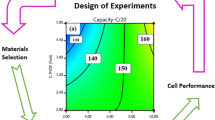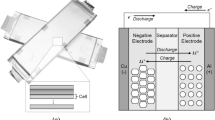Abstract
The investigation of design parameters is very helpful for optimizing the capacity of an electrochemical cell, which can be done by both experimental and numerical methods. In this study, a lead-acid battery has been simulated numerically using the CFD commercial software package FLUENT. The governing equations, including conservation of charge in solid and liquid phases and conservation of species, are solved by developing several user defined functions (UDF). The effect of some basic parameters such as electrode porosity, discharge current density, and width of the electrodes and separator on the cell voltage behavior of a lead-acid battery is investigated. It has been shown that increasing the width and porosity of separator has both positive and negative effects on the performance parameters of battery. Furthermore, a thicker PbO2 electrode has a more pronounced effect than a thicker Pb one.
Similar content being viewed by others
References
J. Newman and W. H. Tiedemann, Porous-electrode theory with battery applications, AIChE Journal, 21(1) (1975) 25–41.
W. H. Tiedemann and J. Newman, Battery design and optimization, Journal of Electrochemical Society, Softbound Proceeding Series, Princeton, New York, 79(1) (1979) 23.
D. M. Bernardi and H. Gu, Two-dimensional mathematical model of a lead acid cell, Journal of Electrochemical Society, 40(8) (1993) 2250–2258.
C. Y. Wang and W. B. Gu, Micro-macroscopic coupled modeling of batteries and fuel cell, Journal of Electrochemical Society, 145(10) (1998) 3407–3417.
H. Gu, T. V. Nguyen and R. E. White, A mathematical model of a lead-acid cell: discharge, rest and charge, Journal of Electrochemical Society, 134(12) (1987) 2953–2960.
S. C. Kim and W. H. Hong, Analysis of the discharge performance of a flooded lead/acid cell using mathematical modeling, Journal of Power Sources, 77 (1999) 74–82.
W. B. Gu, C. Y. Wang and B. Y. Liaw, Numerical modeling of coupled electrochemical and transport processes in lead acid cell, Journal of Electrochemical Society, 144(6) (1997) 2053–2061.
B. Schweighofer and B. Brandstatter, An accurate model for a lead-acid cell suitable for real-time environments applying control volume method, International Journal for Computation and Mathematics in Electrical and Electronic Engineering, 22(3) (2003) 703–714.
V. Esfahanian and F. Torabi, Numerical simulation of leadacid batteries using Keller-Box method, Journal of Power Sources, 158 (2006) 949–952.
V. Esfahanian, F. Torabi and A. Mosahebi, An innovative computational algorithm for simulation of lead-acid batteries, Journal of Power Sources, 176 (2008) 373–380.
F. Torabi and V. Esfahanian, Study of thermal-runaway in batteries, I. Theoretical Study and Formulation, Journal of the Electrochemical Society, 158(8) (2011) A850–A858.
F. Torabi and V. Esfahanian, Study of thermal-runaway in batteries, II. The Main Sources of Heat Generation in Lead-Acid Batteries, Journal of the Electrochemical Society, 160(2) (2013) A223–A234.
V. Esfahanian, H. Mahmoodi Darian, H. Babazadeh, M. Aghvami, R. Pasandeh, F. Torabi and G. Ahmadi, Numerical simulation of electrolyte particles trajectory to investigate battery cover design characteristics, Journal of Power Sources, 191 (2009) 139–143.
J. Newman, Electrochemical systems, 3rd ed., Prentice Hall, Englewood, NJ (1991).
H. Bode, Lead-acid batteries, Brodd RJ and Karl V Kordesch Translators, Wiley, New York, (1977).
ANSYS Fluent 14.1 User Manual, ANSYS Inc., (2011).
Author information
Authors and Affiliations
Corresponding author
Additional information
Recommended by Editor Maenghyo Cho
Vahid Esfahanian received his BSc from the University of Illinois at Chicago, IL, USA in 1982 and his MSc and Ph.D. from the Ohio State University, OH, USA in 1985 and in 1991, respectively. He is now a Full Professor in the School of Mechanical Engineering and the head of Vehicle, Fuel, and Environment Research Institute (VFERI), University of Tehran, Iran. His research interests include battery simulations and hybrid vehicles.
Amir Babak Ansari received his BSc and MSc in Mechanical Engineering from the Shahid Bahonar University of Kerman, Iran, in 2008 and 2011. He has been pursuing his Ph.D. at the University of Tehran since 2011 and he has been working at the Vehicle, Fuel, and Environment Research Institute (VFERI), University of Tehran, Iran since October 2011. His research interests include CFD simulation of battery and energy storage systems.
Hassan Bahramian received his BSc in Mechanical Engineering from the University of Tehran, Tehran, Iran in July 2012. He has been pursuing his MSc in Energy Engineering in the Polytechnic University of Milan, Milan, Italy since October 2012. His research interests include energy storage, renewable energy systems and low carbon technologies and internal combustion engines.
Pooyan Kheirkhah received his BSc in Mechanical Engineering from the University of Tehran, Tehran, Iran, in July 2012. He currently is an MSc student and a researcher in Thermo-Fluids group at the department of Mechanical engineering, UBC.
Goodarz Ahmadi serves as Dean of Wallace H. Coulter School of Engineering at Clarkson University. He is the director of the Turbulence and Multiphase Flow Laboratory, TMFL and is a fellow of ASME, ISME and ISCE. He was also a Senior Research Associate at National Energy Technology Laboratory (NETL).
Rights and permissions
About this article
Cite this article
Esfahanian, V., Ansari, A.B., Bahramian, H. et al. Design parameter study on the performance of lead-acid batteries. J Mech Sci Technol 28, 2221–2229 (2014). https://doi.org/10.1007/s12206-014-0123-5
Received:
Revised:
Accepted:
Published:
Issue Date:
DOI: https://doi.org/10.1007/s12206-014-0123-5




